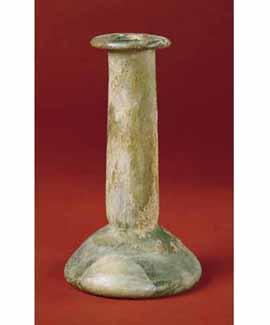|
Conservative Glassblowing
By the early 2nd century A.D., the entrepreneurs
of the glassworking industry most likely were the descendents, three
or four generations removed, of the slaves who in Republican and
Augustan times had been treated simply as household chattels. Changes
in shape and decoration of Roman glassware generally were quite
conservative, with only minor modifications of glassware's mid-to-late
1st century A.D. aspects, rather than sharp departures from them.
Perhaps this was the result of a reasonable caution on the part
of new workshop owners who, if we are right in identifying their
slave origins, had improved their lot amid formidable social barriers.
Or the conservatism may reflect the fact that glassworking was not
being infused by much fresh blood at this time: rather, it was based
on father-to-son training and inheritance.
During the 2nd century A.D. the shape of free-blown
unguentaria evolved gradually in two directions that modified the
body's shape from a flare-mouthed bell to either a wide-mouthed
cone or a squat discoid. The base was now often concave, becoming
more exaggerated in that sense as time went on. The neck became
far more extended, presumably to slow evaporation of the contents.
|
|

Unguentarium
Mid 2nd century A.D.
Ht., 14.7 cm
|

